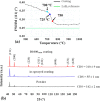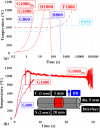Effect of Various Heat Treatments on the Microstructure of 316L Austenitic Stainless Steel Coatings Obtained by Cold Spray
- PMID: 37519327
- PMCID: PMC9033261
- DOI: 10.1007/s11666-022-01402-3
Effect of Various Heat Treatments on the Microstructure of 316L Austenitic Stainless Steel Coatings Obtained by Cold Spray
Abstract
Industries developing cold spray aim at dense and resistant coatings for component repair. However, as-sprayed 316L coatings display non-equilibrium microstructure and brittle fracture behavior. Improving their mechanical properties requires controlling their microstructure; post-spraying heat treatment is a promising approach. The recovery and recrystallization of coatings were little studied, and heat treatments reported in literature mostly used holding for long time in furnaces, not adapted to on-site repairs. This study aimed at gaining insights into recovery and recrystallization mechanisms of 316L coatings, for a broader range of heat treatment kinetics. A study of powders and as-sprayed coatings was conducted to characterize the initial state. In situ XRD measurements provided input for heat treatment definition. Microscopy, room temperature XRD and hardness measurements allowed to better understand the microstructural evolutions and to select treatments leading to original microstructures. In this work, a variety of microstructures were produced by adapting heat treatment conditions for a given set of spraying parameters. The recrystallization path of the heterogeneous skin-core microstructure of deposited particles, as well as the interaction between grain growth and precipitation was revealed. A novel, optimized fast heat treatment led to a fully recrystallized, fine-grained coating and significantly reduced hardness.
Keywords: austenitic stainless steels; cold gas dynamic spraying; heat treatment; microstructure; recrystallization.
© ASM International 2022.
Figures














References
-
- H. Assadi, F. Gärtner, T. Stoltenhoff and H. Kreye, Bonding Mechanism in Cold Gas Spraying, Acta Mater., 2003, 51, p 4379-4394. 10.1016/S1359-6454(03)00274-X
-
- S. Adachi and N. Ueda, Effect of Cold-Spray Conditions using a Nitrogen Propellant Gas in AISI 316L Stainless Steel Coating Microstructures, Coat., 2017, 7, p 87-96. 10.3390/coatings7070087
-
- R. Maestracci, Influence de la Microstructure sur les Mécanismes D’endommagement Thermomécanique de Revêtements à base d’acier Inoxydable AISI 316L Réalisés Par Projection Dynamique Par Gaz Froid « cold spray » (Influence of the microstructure on the thermomechanical damage mechanisms of AISI 316L stainless steel coatings produced by cold spray), PhD thesis, MINES ParisTech, 2016, https://pastel.archives-ouvertes.fr/tel-01561419, in French
-
- X. Jiang, N. Overmann, C. Smith and K. Ross, Microstructure, Hardness and Cavitation Erosion Resistance of Different Cold Spray Coatings on Stainless Steel 316 for Hydropower Applications, Mater. Today Commun., 2020, 25, p 101305. 10.1016/j.mtcomm.2020.101305
-
- C. Widener, M. Carter, O. Ozdemir, R. Hrabe, B. Hoiland, T. Stamey, V. Champagne and T.J. Eden, Application of High Pressure Cold Spray for an Internal Bore Repair if a Navy Valve Actuator, J. Therm. Spray Technol., 2016, 25, p 193-201. 10.1007/s11666-015-0366-4
Publication types
LinkOut - more resources
Full Text Sources
